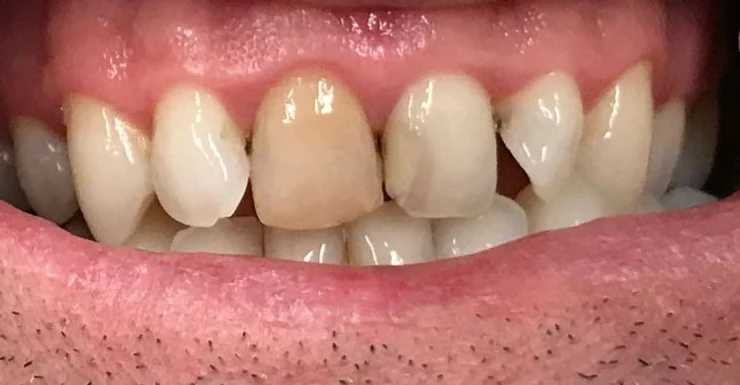 October 1, 2018
October 1, 2018
Healthy teeth have vitality – a life source of nutrients supplied from the blood stream via the pulp. When this blood supply has become cut off, old blood cells break down and stain the dentine.
Blood supply can become cut off for 2 main reasons:
1. Trauma or a knock to the tooth. The soft body tissues usually swell after they have been injured, to try and repair the damaged cells. When the pulp tries to swell it cannot because it is encased in a hard tooth. The pulp effectively chokes itself with swelling, cutting off the blood supply and causing the death of the pulp.
2. Infection. Bacteria can enter via a hole where decay is or where decay has been. Dental fillings do not last forever, and when they leak, bacteria can sneak in the microscopically small gap. The result can be a toothache, or sometimes the nerve dies in a painless way. Bacteria can also enter via cracks in teeth that are sometimes not visible to the eye.
The dentist will assess the tooth with simple tests to see if the nerve is still alive.
-Tapping the tooth – tenderness suggests some sort of inflammation.
-Looking at the gum near the tip of the root for redness or swelling.
-Colour change of the tooth or darkening.
-Thermal tests with cold ice or heat sticks. Normal teeth will feel temperature changes.
-Electrical tests, running a small current through the tooth. Normal teeth feel a tingle.
-Xrays can show traumatic cracks in teeth, decay, and established infections.
If the pulp is pronounced dead at the scene, a root canal treatment may be advised. On a separate visit, the dentist may use an anaesthetic to numb the tooth. The dentist will drill a small hole in the back of the tooth, flush out the dead tissue with disinfectant and a tiny bottle-brush type metal stick. An orange rubber stick is then used to fill up the canal and melted down with mild heat to seal the canal. The tooth will still be dark.
To change the colour of the treated tooth, there are 2 methods.
1. Bleaching. The filling is partially removed and bleach crystals are packed inside the tooth. The crystals may be refreshed or repacked every couple of days until the desired result is achieved. The problem with this technique is that it is unpredictable, and the tooth can become quite hollow inside, making it potentially more likely to fracture.
2. Masking the darkness. A veneer of composite resin or a crown of porcelain can cover over the darkness. The advantage of resin is that no tooth needs to be removed, meaning the natural tooth remains intact. Imagine a false fingernail type of thing. Crowns can look amazing but do require the tooth to be cut away. Crowns are a strong option to but ultimately the dentist will decide what will work best.
